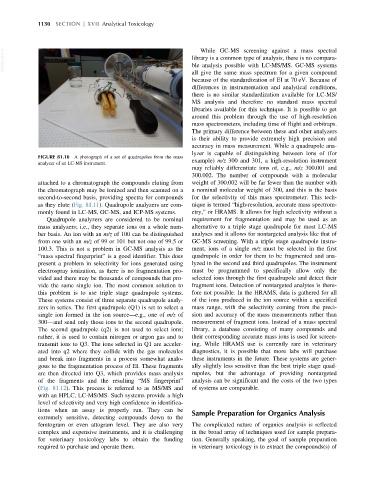Page 1198 - Veterinary Toxicology, Basic and Clinical Principles, 3rd Edition
P. 1198
1130 SECTION | XVII Analytical Toxicology
VetBooks.ir library is a common type of analysis, there is no compara-
While GC-MS screening against a mass spectral
ble analysis possible with LC-MS/MS. GC-MS systems
all give the same mass spectrum for a given compound
because of the standardization of EI at 70 eV. Because of
differences in instrumentation and analytical conditions,
there is no similar standardization available for LC-MS/
MS analysis and therefore no standard mass spectral
libraries available for this technique. It is possible to get
around this problem through the use of high-resolution
mass spectrometers, including time of flight and orbitraps.
The primary difference between these and other analyzers
is their ability to provide extremely high precision and
accuracy in mass measurement. While a quadrupole ana-
lyzer is capable of distinguishing between ions of (for
FIGURE 81.10 A photograph of a set of quadrupoles from the mass
analyzer of an LC-MS instrument. example) m/z 300 and 301, a high-resolution instrument
may reliably differentiate ions of, e.g., m/z 300.001 and
300.002. The number of compounds with a molecular
attached to a chromatograph the compounds eluting from weight of 300.002 will be far fewer than the number with
the chromatograph may be ionized and then scanned on a a nominal molecular weight of 300, and this is the basis
second-to-second basis, providing spectra for compounds for the selectivity of this mass spectrometer. This tech-
as they elute (Fig. 81.11). Quadrupole analyzers are com- nique is termed “high-resolution, accurate mass spectrom-
monly found in LC-MS, GC-MS, and ICP-MS systems. etry,” or HRAMS. It allows for high selectivity without a
Quadrupole analyzers are considered to be nominal requirement for fragmentation and may be used as an
mass analyzers; i.e., they separate ions on a whole num- alternative to a triple stage quadrupole for most LC-MS
ber basis. An ion with an m/z of 100 can be distinguished analyses and it allows for nontargeted analysis like that of
from one with an m/z of 99 or 101 but not one of 99.5 or GC-MS screening. With a triple stage quadrupole instru-
100.3. This is not a problem in GC-MS analysis as the ment, ions of a single m/z must be selected in the first
“mass spectral fingerprint” is a good identifier. This does quadrupole in order for them to be fragmented and ana-
present a problem in selectivity for ions generated using lyzed in the second and third quadrupoles. The instrument
electrospray ionization, as there is no fragmentation pro- must be programmed to specifically allow only the
vided and there may be thousands of compounds that pro- selected ions through the first quadrupole and detect their
vide the same single ion. The most common solution to fragment ions. Detection of nontargeted analytes is there-
this problem is to use triple stage quadrupole systems. fore not possible. In the HRAMS, data is gathered for all
These systems consist of three separate quadrupole analy- of the ions produced in the ion source within a specified
zers in series. The first quadrupole (Q1) is set to select a mass range, with the selectivity coming from the preci-
single ion formed in the ion source—e.g., one of m/z of sion and accuracy of the mass measurements rather than
300—and send only those ions to the second quadrupole. measurement of fragment ions. Instead of a mass spectral
The second quadrupole (q2) is not used to select ions; library, a database consisting of many compounds and
rather, it is used to contain nitrogen or argon gas and to their corresponding accurate mass ions is used for screen-
transmit ions to Q3. The ions selected in Q1 are acceler- ing. While HRAMS use is currently rare in veterinary
ated into q2 where they collide with the gas molecules diagnostics, it is possible that more labs will purchase
and break into fragments in a process somewhat analo- these instruments in the future. These systems are gener-
gous to the fragmentation process of EI. These fragments ally slightly less sensitive than the best triple stage quad-
are then directed into Q3, which provides mass analysis rupoles, but the advantage of providing nontargeted
of the fragments and the resulting “MS fingerprint” analysis can be significant and the costs of the two types
(Fig. 81.12). This process is referred to as MS/MS and of systems are comparable.
with an HPLC, LC-MS/MS. Such systems provide a high
level of selectivity and very high confidence in identifica-
tions when an assay is properly run. They can be Sample Preparation for Organics Analysis
extremely sensitive, detecting compounds down to the
femtogram or even attogram level. They are also very The complicated nature of organics analysis is reflected
complex and expensive instruments, and it is challenging in the broad array of techniques used for sample prepara-
for veterinary toxicology labs to obtain the funding tion. Generally speaking, the goal of sample preparation
required to purchase and operate them. in veterinary toxicology is to extract the compounds(s) of

